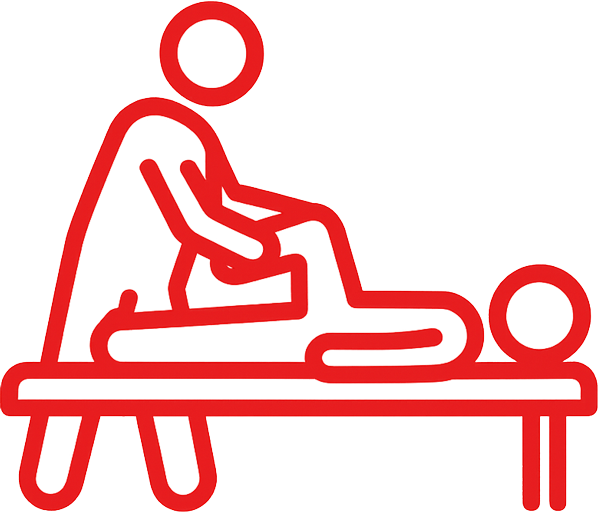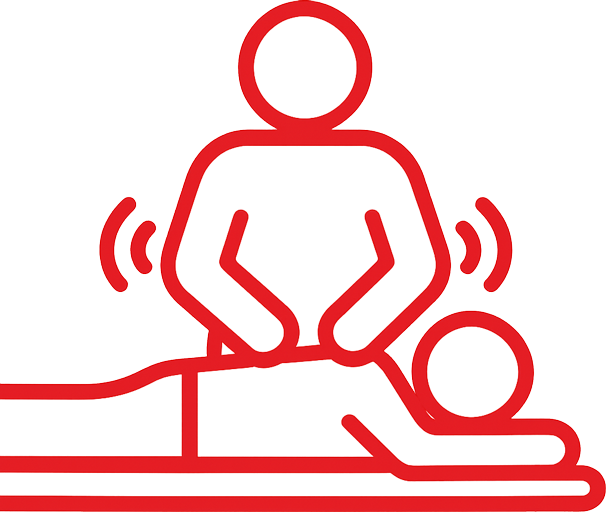Sciatica Treatment in St. Paul, Minnesota
Get lasting relief from sciatic nerve pain and leg pain without surgery
Natural Sciatica Treatment
Sciatica is a painful condition that affects the sciatic nerve, causing pain that radiates from the lower back down through the leg. At Twin Cities Chiropractic, Dr. Scot Sorum specializes in treating sciatica naturally by addressing the underlying causes rather than just masking the symptoms. With 25 years of experience, Dr. Sorum understands how debilitating sciatica can be and is committed to helping you find lasting relief without surgery or long-term medication dependency.

What Is Sciatica and What Causes It?
Sciatica is not a diagnosis itself, but a symptom of an underlying problem affecting the sciatic nerve:
Common Causes of Sciatica

Herniated Disc
Disc material pressing on the sciatic nerve root

Bulging Disc
Disc protrusion causing nerve compression

Spinal Stenosis
Narrowing of the spinal canal compressing nerves

Piriformis Syndrome
Tight piriformis muscle compressing the sciatic nerve

Spondylolisthesis
Vertebra slipping forward over another vertebra

Degenerative Disc Disease
Age-related disc deterioration
Risk Factors

Age-related Changes
Natural wear and tear on spine

Prolonged Sitting
Especially with poor posture

Heavy Lifting
Improper lifting techniques

Obesity
Extra weight putting pressure on spine

Diabetes
Affecting nerve health

Sedentary Lifestyle
Weak core and back muscles
Recognizing Sciatica Symptoms
Primary Symptoms

Radiating Leg Pain
Sharp, shooting pain from lower back to leg

Lower Back Pain
Often accompanies leg pain

Numbness & Tingling
In leg, foot, or toes

Muscle Weakness
In affected leg or foot

Burning Sensation
Along the path of the sciatic nerve

Electric Shock-like Pain
Sudden, severe pain episodes
Pain Patterns

Unilateral Pain
Usually affects one side of the body

Worsening with Sitting
Pain increases when seated

Relief when Walking
Movement may temporarily ease pain

Coughing or Sneezing Pain
Sudden increase in symptoms

Nighttime Pain
Difficulty sleeping due to discomfort
Functional Limitations

Difficulty Sitting
Especially for prolonged periods

Problems Standing
From sitting position

Walking Difficulties
Limping or altered gait

Sleep Disruption
Pain interfering with rest

Work Limitations
Reduced productivity and missed days

Daily Activity Restrictions
Difficulty with routine tasks
Effective, Non-Surgical Sciatica Relief
Comprehensive Evaluation
Detailed pain history and symptom assessment with Dr. Sorum
Physical examination including neurological testing
Orthopedic tests to identify nerve involvement
Range of motion and strength assessment
Postural analysis and gait evaluation
X-rays or MRI review when necessary
Treatment Options
Chiropractic Care

Spinal Adjustments
Restore proper alignment and reduce nerve pressure
Targeted Manipulation
Specific techniques for sciatic nerve relief
Flexion Distraction
Gentle technique for disc-related sciatica
Advanced Therapies

Spinal Decompression
Non-surgical treatment to relieve disc pressure

Physical Therapy
Strengthen core and back muscles, improve flexibility

Massage Therapy
Joy Vang's therapeutic massage reduces muscle tension and inflammation
Pain Management

Natural Pain Relief
methods without drugs

Heat & Cold Therapy
applications

Electrical Stimulation
for pain control

Activity Modifications
and ergonomic training
Targeted Treatment for Different Types of Sciatica
Disc-Related Sciatica
Spinal Decompression Therapy
to reduce disc pressure
Specific Adjustments
to improve disc position
McKenzie Exercises
for disc rehabilitation

Activity Modifications
to promote disc healing
Piriformis Syndrome

Piriformis Muscle Syndrome
through massage and stretching

Hip Adjustments
to improve pelvic alignment

Targeted Exercises
to strengthen hip muscles

Postural Corrections
to reduce piriformis tension
Spinal Stenosis Sciatica

Flexion-based Exercises
to open spinal canal

Gentle Decompression
techniques

Postural Training
to maintain spine extension

Core Strengthening
to support spinal stability
Chronic Sciatica

Comprehensive Rehabilitation
programs
Multi-Modal Approach
combining various treatments

Lifestyle Modifications
for long-term management

Maintenance Care
to prevent recurrence
Preventing Future Sciatica Episodes
Strengthening Exercises

Core Strengthening
Build stability for spine support

Glute Strengthening
Improve hip and pelvic stability

Back Muscle Exercises
Strengthen erector spinae muscles

Hip Flexor Stretches
Maintain flexibility and reduce tension
Lifestyle Modifications

Proper Lifting Techniques
Bend knees, keep back straight

Ergonomic Improvements
Better seating and workstation setup

Regular Movement
Avoid prolonged sitting or standing

Weight Management
Reduce pressure on spine and discs
Posture and Body Mechanics

Sitting Posture
Maintain lumbar curve, feet flat on floor

Standing Posture
Distribute weight evenly on both feet

Sleeping Position
Side sleeping with pillow between knees

Daily Activities
Proper body mechanics for all tasks
Don't Wait - Sciatica Can Worsen Without Treatment
Seek Immediate Treatment If
Leg pain is severe and interferes with daily activities
Numbness or weakness in leg or foot
Pain persists for more than a week
Symptoms are progressively worsening
Difficulty controlling bladder or bowel (emergency)
Loss of sensation in genital area (emergency)
Benefits of Early Treatment

Prevent Chronicity
Avoid long-term nerve damage

Faster Recovery
Earlier intervention leads to quicker healing

Avoid Surgery
Conservative treatment often eliminates need for surgery

Prevent Disability
Maintain function and quality of life

Reduce Complications
Prevent secondary problems from altered movement
25 Years of Sciatica Treatment Expertise
Dr. Scot Sorum brings a quarter-century of experience treating sciatica and sciatic nerve conditions to Twin Cities Chiropractic. As a Northwestern College of Chiropractic graduate who founded the practice in 2001, Dr. Sorum has successfully helped thousands of patients find natural relief from sciatica.
His comprehensive approach includes
Advanced Diagnostic Skills
Identifying the exact cause of your sciatica
Multiple Treatment Techniques
Tailored to your specific condition
Conservative Care Focus
Helping you avoid surgery when possible
Prevention Education
Teaching you how to prevent future episodes
Natural Sciatica Relief You Can Trust
Experienced Doctor

Dr. Sorum
25 years treating sciatica and nerve conditions

Thousands
of successful sciatica patients treated

Specialized Expertise
in disc-related and nerve compression conditions

Conservative Approach
focusing on natural healing
Comprehensive Treatment

Multiple Treatment Modalities
for different types of sciatica

Integrated Care
combining chiropractic, decompression, and massage

Advanced Equipment
including spinal decompression technology

Joy Vang's Massage Therapy
targets muscle tension contributing to sciatica
Proven Results
High Success Rates
helping patients avoid surgery
Patient Testimonials
documenting significant improvements
Long-term Relief
addressing root causes, not just symptoms
Functional Restoration
getting you back to normal activities
Common Sciatica Treatment Questions
Recovery time varies depending on the underlying cause. Some patients see improvement within days, while others may take several weeks. Dr. Sorum will provide a realistic timeline based on your specific condition.
While we can’t “cure” sciatica, we can often eliminate symptoms and teach you how to prevent future episodes through proper care and lifestyle modifications.
Most sciatica cases respond well to conservative treatment. Surgery is typically only considered when conservative care fails and there are serious neurological symptoms.
Certain exercises can be very beneficial for sciatica, while others may worsen symptoms. Dr. Sorum will guide you on appropriate activities for your condition.
Yes, prolonged sitting often increases pressure on discs and can worsen sciatica symptoms. Dr. Sorum will teach you proper sitting techniques and recommend frequent position changes.
Sciatica specifically involves the sciatic nerve and typically causes pain that radiates down the leg, while regular back pain usually stays localized to the back area.
Severe Sciatica? We Can Help Today
Same-Day Appointments Available
Severe Leg Pain
preventing normal activities
New Onset Sciatica
with significant symptoms
Worsening Sciatica
not responding to home care
Work-related
or auto accident sciatica
Emergency Situations - Seek Immediate Medical Care
Loss of bladder or bowel control
Progressive weakness in leg or foot
Numbness in genital area or inner thighs
Severe pain in both legs
Inability to move leg or foot
Comprehensive Sciatica Treatment
Dr. Sorum’s sciatica treatment is enhanced by our integrated approach:

Chiropractic Adjustments
Restore proper spinal alignment and reduce nerve pressure

Spinal Decompression
Advanced technology for disc-related sciatica

Physical Therapy
Strengthen core muscles and improve flexibility

Massage Therapy
Joy Vang's therapeutic massage reduces muscle tension and inflammation

Lifestyle Counseling
Address contributing factors and prevention strategies
Comprehensive Nerve and Spine Care

Lower Back Pain
Often accompanies or causes sciatica

Herniated Disc
Common underlying cause of sciatica

Piriformis Syndrome
Muscle-related cause of sciatic symptoms

Spinal Stenosis
Narrowing causing nerve compression

Hip Pain
Can be related to sciatic nerve irritation

Leg Numbness
Nerve-related symptoms we address
Supporting Your Recovery at Home
Helpful Exercises (when appropriate)
Knee to Chest Stretches
Gentle lumbar flexion
Piriformis Stretches
Target deep hip muscles
Hamstring Stretches
Reduce leg muscle tension
Pelvic Tilts
Improve lower back flexibility

Walking
Low-impact exercise to promote healing
Home Care Tips

Ice Therapy
For acute inflammation (first 48 hours)

Heat Therapy
For muscle tension and chronic pain

Proper Sleep Positioning
Side lying with pillow between knees

Activity Modification
Avoid aggravating positions and activities

Ergonomic Adjustemnts
Improve seating and workstation setup
Important: Always consult with Dr. Sorum before starting any exercise program for sciatica.
Prevent Future Sciatica Episodes
Daily Habits

Take Frequent Breaks
Stand and move every 30 minutes when sitting

Maintain Good Posture
Keep lumbar curve when sitting

Sleep Properly
Use supportive mattress and proper pillow placement

Stay Active
Regular exercise to maintain spine health
Workplace Ergonomics

Adjust Chair Height
Feet flat on floor, knees at 90 degrees

Use Lumbar Support
Maintain natural back curve

Position Monitor
At eye level to avoid neck strain

Take Movement Breaks
Walk and stretch regularly
Exercise and Fitness

Strengthen Your Core
Support your spine with strong abdominal muscles

Stretch Regularly
Maintain flexibility in hips and legs

Low-impact Activities
Walking, swimming, cycling

Avoid High-impact Sports
During recovery and if prone to sciatica
